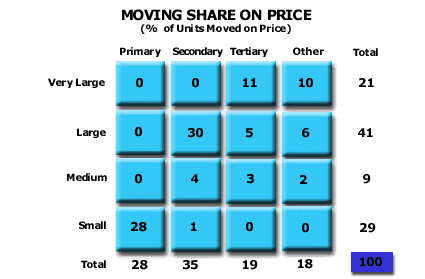Analysis 49: Market Segments Where Share Moves on Low Price
EXHIBITS:

| HOW TO INTERPRET THE ANALYSIS: This exhibit shows where low prices have moved market share on the Customer Size/Supplier Role matrix. Low price moves market share most notably in Large and Small customers. Also, low price gains some share in each of the Roles on the matrix. Overall the greatest opportunity for market share gain using low-price rests with the segments of Large Customers/ Secondary Role and Small Customers/Primary Roles. The Very Large customers use low-priced competitors only in the outlying Tertiary and other Roles. The Very Large customers probably use low-priced competitors in these two Roles for Price Leverage. Only the Small customers seem willing to use a supplier in the Primary Role position based only on a low price.
PURPOSE: Before the Company would initiate any form of price reduction to gain share in the marketplace, it should know the market segments where a low price gains volume. This analysis shows where, on the customer size and role segmentation matrix, share is moving on low price. APPROACH: This analysis evaluates only the Positive Volatility volume moved on low price. The base volume is all Positive Volatility (Get In and Increase Use) that moved on the basis of price. The Company distributes this price-based volume across the customer size and role segmentation matrix to determine what percentage of the total volume that moved on price occurred in each position on the matrix. Armed with this analysis, the Company should decide, first, whether the use of low price would provide it with strategically attractive new volume and, second, whether valuable volume is leaving the Company because the Company's price is too high. In order to make this second decision, the Company may wish to conduct this analysis for its own Negative Volatility due to price. Return to Diagnose Pricing: Price Sensitivity and Competition |
|
Recommended Reading |
| For a greater overall perspective on this subject, we recommend the following related items:
Analyses: Symptoms and Implications: Symptoms developing in the market that would suggest the need for this analysis.
Perspectives: Conclusions we have reached as a result of our long-term study and observations.
|
